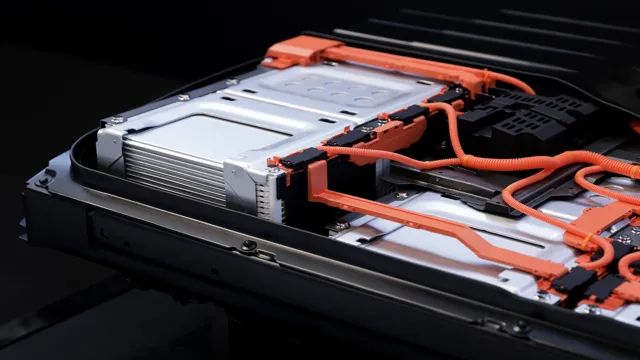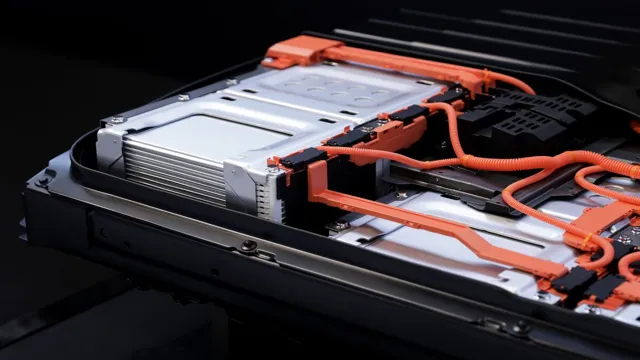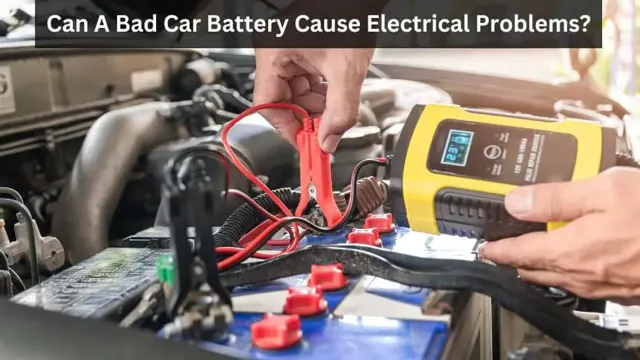Uncovering the Truth: Is the Location of Electric Car Batteries Safe?
Electric cars were once a thing of the future – something many people only dreamed of. But as technology advances, our dreams turned into reality. Today, we are seeing more and more electric vehicles on the roads than ever before, and it’s easy to understand why.
Not only do they offer a more sustainable and environmentally-friendly way to travel, but they are also more affordable to run. However, one question that many people still have is whether or not electric car batteries are safe. After all, they are a key component of the vehicle and essential for its smooth running.
In this blog, we’ll dive deeper into this topic and explore the safety implications of electric car batteries.
Battery Location and Safety
Electric cars are becoming more and more popular, and one of the most important aspects of this emerging technology is the battery. The location of the battery is an important consideration, as it plays a crucial role in the safety of the vehicle. Many electric cars place the battery in the center of the vehicle, beneath the passenger compartment.
This is because it provides a more balanced weight distribution, which can improve handling and stability. However, it also raises concerns about safety, as the battery is a high-voltage component that can be dangerous in the event of an accident. To mitigate this risk, manufacturers have developed safety features such as special crash sensors and fire suppression systems, as well as detailed protocols for first responders to follow in the event of an accident.
Overall, while there are some safety concerns associated with the location of electric car batteries, the industry has taken steps to ensure that they are as safe as possible for drivers and passengers alike.
Electric Car Battery Placement
When it comes to electric car design, battery placement and safety are important considerations. The location of the battery can affect the car’s performance, range, and safety. Most electric cars have their batteries placed in the floor, which lowers the center of gravity and improves stability.
This placement also provides better weight distribution, which can improve handling. Additionally, placing the battery in the floor can help protect it in the event of a collision. However, there are still potential risks associated with electric car batteries, such as the risk of fire in the event of damage.
To mitigate this risk, electric car manufacturers have implemented numerous safety features, such as battery enclosures, cooling systems, and monitoring systems to detect any issues that could lead to fires. As the demand for electric cars continues to increase, battery placement and safety will remain crucial areas of focus for car designers and manufacturers.

Safety Features in Electric Car Batteries
When it comes to electric car batteries, safety is a top priority. One of the key safety features is the location of the battery. Unlike traditional gasoline-powered cars where the fuel is located in a tank located underneath or behind the car, electric car batteries are generally located in the floor of the car.
This location not only helps with weight distribution but also makes the battery less likely to be damaged in the event of a collision. Additionally, the battery is surrounded by a protective casing which helps to prevent damage from external sources such as debris on the road. Overall, the location of the battery in electric cars is a crucial safety feature, making these vehicles safer to drive on the road.
Battery Safety Standards
Many people are curious about the safety of electric car batteries and their location within the vehicle. The good news is that battery safety standards are very strict and measure multiple factors, including size, temperature, and impact resistance. Electric car batteries are typically located in a very secure location, such as beneath the vehicle’s floorpan or in a protective casing.
Additionally, safety features like automatic cutoffs and fire suppression systems are built into most electric cars to reduce the risk of a potential fire. So overall, while it’s always important to exercise caution with any technology, electric car batteries are designed and built with safety as a top priority.
International Safety Standards
Battery safety standards are a crucial aspect of international safety standards because batteries are an essential component of many devices. These standards provide guidelines for manufacturers to ensure that their products are safe, reliable, and meet specific performance criteria. One example of an international standard is the IEC 62133, which sets requirements for the safety and performance of portable sealed rechargeable batteries.
These requirements include testing for electrical, mechanical, and thermal safety, as well as defining how the battery should be designed, labeled and manufactured. Compliance with these standards helps to minimize the risk of overheating, short-circuiting, or explosion, which can occur when batteries are poorly designed or manufactured. As consumers, we rely on these safety standards to reduce the risks associated with using batteries and to ensure that our devices are safe to use.
So, it’s essential to choose products that comply with these standards when selecting batteries for your device.
Battery Testing and Certification
Battery safety standards are critical for ensuring the safety and effectiveness of batteries. Batteries are used in a range of applications, from portable electronic devices to electric cars and renewable energy systems. As batteries have become more widespread, there has been a growing need for safety standards to ensure that batteries are reliable and do not pose a risk to users.
These standards are developed by organizations such as the United Nations, International Electrotechnical Commission (IEC), and Underwriters Laboratories (UL). They cover a range of topics, including battery construction and material selection, packaging and transportation, and testing and certification procedures. Battery manufacturers must comply with these standards to ensure that their products are safe and reliable.
As consumers, we can trust that batteries that have been certified conform to strict safety standards.
Battery Recycling and Disposal
When it comes to battery recycling and disposal, safety standards are of utmost importance. These standards are in place to prevent injury and damage to the environment. One such standard is the design of batteries themselves.
Many modern batteries are designed to be non-toxic and non-flammable, reducing the risk of harm. However, it is still important to handle batteries with care. If a battery is damaged or leaking, it should be placed in a designated container and not thrown in the trash.
Additionally, batteries should never be incinerated as they may release harmful toxins into the air. By following safety standards and properly disposing of batteries, we can protect ourselves and our environment.
Choosing a Safe Electric Car
When it comes to shopping for an electric car, many potential buyers are concerned about the safety of the batteries. One of the main factors that determine the safety level of electric car batteries is their location within the vehicle. Generally, electric car batteries are located at the bottom of the car, which lowers the car’s center of gravity and makes it less likely to roll over in an accident.
Additionally, most electric cars are designed with advanced safety features that are specifically meant to protect the battery in the event of a collision. These features may include specialized crumple zones, fire retardant materials, and even a system that automatically disconnects the battery in the event of an accident. Overall, when choosing an electric car, it’s important to keep in mind that the location of the batteries and the safety features of the vehicle are both key factors that can contribute to your peace of mind on the road.
Researching Battery Safety Ratings
When choosing an electric car, it’s crucial to look into battery safety ratings. After all, the battery is essentially the heart of the vehicle, powering every mile you drive. Thankfully, there are several reliable resources available to help you research these ratings and make an informed decision.
One valuable tool is the National Highway Traffic Safety Administration’s (NHTSA) five-star safety rating system, which includes a category for “Overall Vehicle Score” that takes into account factors like crash test results and advanced safety features. Additionally, organizations like the Insurance Institute for Highway Safety (IIHS) also offer safety ratings and crash test results specifically for electric vehicles. While it may take a bit of extra effort to do this research, it’s well worth it for the peace of mind that comes with knowing you’ve chosen a safe electric car.
Buying from Reputable Brands
When it comes to choosing a safe electric car, it’s important to buy from reputable brands. These brands have a reputation to maintain, so they prioritize safety as one of their top concerns and invest heavily in ensuring their cars meet safety standards. These brands also have a track record of producing electric cars that have undergone rigorous testing and have the latest safety features.
By choosing a reputable brand, you can have peace of mind knowing that you’re driving a car that has been thoroughly tested and certified as safe. Furthermore, these brands typically offer warranties that cover any defects that may affect the safety of the car. In short, it’s always a wise decision to choose a safe electric car from a reputable brand that puts safety first.
Conclusion: Electric Car Batteries are Safe
As with any technology, there are potential risks involved with the location of electric car batteries. However, advancements in design and safety measures have made these batteries remarkably safe. In fact, statistically speaking, your everyday gasoline-powered car is likely more dangerous than an electric car with its battery safely tucked away.
So go ahead and cruise in your electric car, knowing that not only are you saving the environment, but you’re doing it in style and safety.”
FAQs
What are electric car batteries made of?
Electric car batteries are typically made of lithium-ion cells.
Where is the location of electric car batteries?
The location of electric car batteries varies depending on the model and make of the car, but they are typically located under the car’s floor.
Is it safe to install and handle electric car batteries?
Installing and handling electric car batteries should be left to professionals due to the high voltage and potential hazards involved.
How long does the lifespan of an electric car battery last?
The lifespan of an electric car’s battery varies depending on usage and maintenance, but typically ranges from 8-10 years.
How do electric car batteries compare to traditional gas car batteries?
Electric car batteries are more expensive than traditional gas car batteries, but they have a longer lifespan and are more environmentally friendly.





